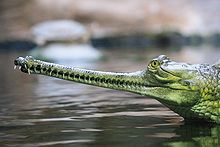Gavialoidea
| Gavialoidea | |
|---|---|

| |
| Indian gharial, Gavialis gangeticus | |
| Scientific classification | |
| Domain: | Eukaryota |
| Kingdom: | Animalia |
| Phylum: | Chordata |
| Class: | Reptilia |
| Clade: | Archosauromorpha |
| Clade: | Archosauriformes |
| Order: | Crocodilia |
| Clade: | Longirostres |
| Superfamily: | Gavialoidea Hay, 1930 |
| Subgroups | |
| |
Gavialoidea is one of three
Extinct South American gavialoids likely
Classification
Gavialoidea is
Traditionally, crocodiles and alligators were considered more closely related and grouped together in the taxon Brevirostres, to the exclusion of the gharials. This classification was based on morphological studies primarily focused on analyzing skeletal traits of living and extinct fossil species.[5] However, recent molecular studies using DNA sequencing have rejected Brevirostres upon finding the crocodiles and gavialids to be more closely related than the alligators.[6][7][8][4][9] The new clade Longirostres was named by Harshman et al. in 2003.[6]
In addition, these recent molecular DNA studies consistently indicate that the false gharial (Tomistoma) (and by inference other related extinct forms) traditionally viewed as belonging to the crocodylian subfamily Tomistominae actually belong to Gavialoidea (and Gavialidae).[6][10][11][7][8][4][9] As its name suggests, the false gharial was once thought to be only distantly related to the gharial despite its similar appearance. The false gharial and other tomistomines were traditionally classified within the superfamily Crocodyloidea as close relatives of crocodiles, based solely on morphological evidence.[10]
The phylogenetic position group of Late Cretaceous-Cenozoic longirostrine
A 2018
The below
Crocodylia
|
| ||||||||||||||||||||||||||||||
| (crown group) |
However, other analyses by different authors have continued to resolve thoracosaurs as members of Gavialoidea.[12]
